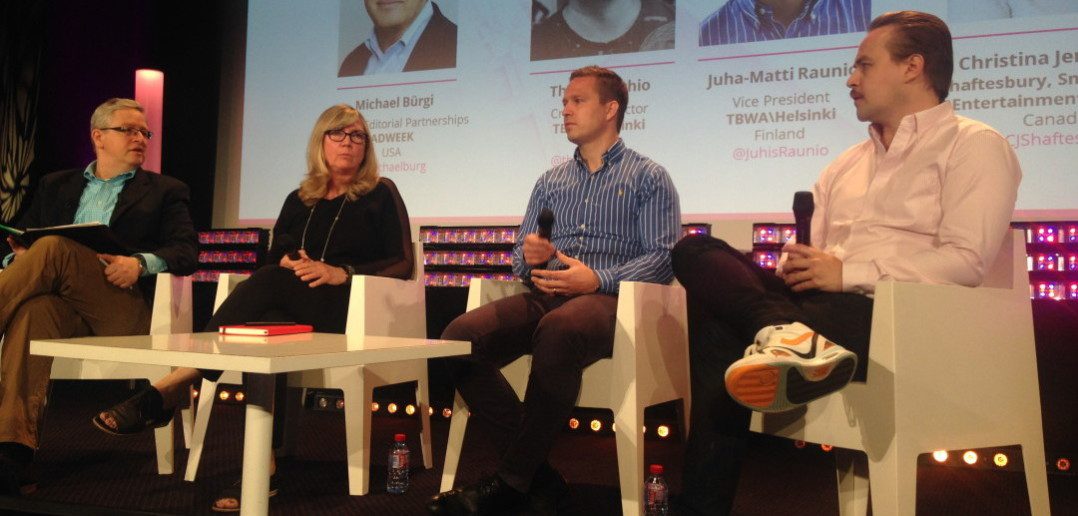Left to right: moderator Michael Bürgi, director of editorial partnerships at Adweek; Christina Jennings of Shaftesbury, Smokebomb Entertainment & shift2; Juha-Matti Raunio, VP of TBWA\Helsinki; and creative director Theodor Arhio of TBWA\Helsinki.
This first brands-as-programmers session, produced in partnership with AdWeek, was dubbed « Video is the new black » and featured chats with people who work with brands to produce TV-ready content.
Our first case study was Buy This!, a TV show created by TBWA\Helsinki. See the case study below:
Buy This! follows a fictional ad agency that works for real clients and features David Hasselhoff. 10 famous brands appear in the story, and the ads actually air at the end of the show. It became the fourth-biggest scripted show on commercial TV.
« Of course we pitched it to our own clients first, but only three clients were our own. It became really good new business for us, » revealed VP Juha-Matti Raunio of TBWA\Helsinki.
« But how did other ad agencies feel about their clients taking up with a fictional agency? » asked Adweek’s Michael Bürgi.
« I would say we’re not the most popular guys in the Helsinki ad world at the moment, » laughed Raunio.
Show placement was positioned as a media buy, explained CD Theodor Arhio. « All advertisers bought a media package, priced in a way that it was a medium-sized campaign for them. The twist in this was, what was included was an active role in a sitcom—something that would link content to the campaign and boost awareness. »
They sold the idea to clients this way: « The show would tell the background story of why you created this campaign. That meant brands could let loose and have fun, » Arhio explained.
Raunio added that placement in all 10 episodes were sold in less than six weeks. « For an ad guy to have a meeting and talk about the TV show, you’ve got the CEO and CMO there, because everybody loves TV, » he said, « so meetings were really easy to book for us. We had 47 meetings in less than six weeks. »
The star effect of the ‘Hoff also helped a lot. « Not everyone sees him as a huge idol, but in Finland he’s God. The Germans know what I’m talking about! » Raunio said, to snickers from the audience (likely Germans).
TBWA\Helsinki is currently working with Fremantle to develop a possible second season, Raunio said. « We want to do something new, see how to use digital more. Although it was groundbreaking, it’s not an excuse to stop innovating. Maybe we’ll come up with a new and better version of it. »
Finland, he said, is a country of 5,3 million people, and the 10 brands in the show got 1,3 Facebook Likes—representing 30% of the entire population. « In that sense it created a new marketing channel. »
But he feels scaling will be simpler than many may assume; they’re already talking to different markets. « Finland is a western country in miniature size so it’s a good place to pilot stuff, » Raunio said. « We have the same attitude as the Western world, » and the concept and format are easy for any country to adopt.
« If the Office can travel, why wouldn’t Buy This! travel? » he concluded.
The next session featured Christina Jennings of Shaftesbury, Smokebomb and shift2, who worked with U by Kotex to create Carmilla, a unique and addictive web series about a college girl who discovers her roommate is a vampire. Below is a « public service announcement » they created with the brand:
« We wanted to get into the Millennial space but we didn’t just want to put stars into YouTube videos, » Jennings began, so « our unique approach was to go to brands and say we’ll only do scripted content on YouTube—long-running series. »
Carmilla was a 36-part scripted series with a suite of brand-focused video extras. « It was about creating scripted content brands could attach to, » Jennings explained.
They were also extremely strict about when and how the brand could intervene creatively. « Brands use YouTube as a dumping ground for whatever miscellaneous videos they have—interviews with CFOs, CEOs—so we told Kotex the videos would live on our YouTube channel, not theirs. We said you won’t identify with this content until we’ve run 20 episodes, » Jennings said, dashing every brand’s dream of concluding a great series with a perky « brought to you by… »
According to Jennings, the last time someone had adopted the novella Carmilla—which predates Bram Stoker’s Dracula—was in the ’60s. « We decided to update it, put it in a dorm and make it a dialogue between two women. It felt cheeky and shared some brand attributes that U by Kotex expressed with its Save the Panties campaign. »
But unlike TBWA\Helsinki, they didn’t have a ‘Hoff to bring automatic charisma to the show. There were no known stars, none that were part of the actor’s union. « We had the original vampire novella that pre-dated Dracula, but that didn’t have a massive following, » said Jennings. « So we put it out for 20 episodes, then told fans that Kotex financed the series. And they went crazy. »
Something special happened around the 20th episode: By then, the fan communities of other popular shows like Orphan Black and Lost Girl had found Carmilla, and were driving traffic to it. The show also developed a strong LGBT following because of a love story that naturally developed within its universe.
Carmilla overall has enjoyed 14 million views with no paid media, but it was a slow build. Bürgi asked whether it was difficult to get Kotex to agree to wait that long.
« We basically said, you have a really strong brand and no YouTube strategy. None, » said Jennings. « So trust us here. Put it on our site, don’t let the fans know—Millennials will smell it in a second if they’re being sold to. »
The future of Carmilla, Jennings believes, is in television, where she’s already checking out a few leads. She believes that although Millennials are disinterested in TV, they’ll follow the show for an opportunity to see that universe expand.
« Budgets are a drop in the budget of what TV costs, » said Jennings, ruminating over the difference between YouTube and television. « But you’ve still got scripts. The brand wants to read the scripts, the broadcaster wants to read the scripts; you’ve still got a creative process. »
The main difference is « the speed in which we shoot, » she concluded. « We’re shooting 36 episodes in four days. » Try to do that for TV.
The panel then opened to audience questions. Asked who owns their intellectual property, Jennings revealed that Smokebomb managed to retain the IP for Carmilla.
« The brand was fine with it, » she said, « they wanted awareness and they wanted sales. Kimberly-Clark could actually see that through awareness of the series, fans were going out to buy the product. They didn’t need to own the IP. »
« We thought of Buy Now! as a branded content platform because it’s 10 brands equally sharing time, » said Raunio. « I’d call Carmilla a branded content original. » He speculated that in the future, it will be « harder to keep the whole IP in the future if it’s a branded content original, but easier if it’s a platform. »
« My guess is in the future, there will be more ownership between brands and production houses, » said Arhio. « At this point, most brands see it as a platform to create awareness, and attach themselves to great content. »
And the sky’s the limit. Asked which sectors are most amenable to their services, Raunio flatly replied, « If Chipotle can do a web series on Hulu, it’s possible for anyone to do branded content. »
Check out MIPTV, MIP Digital Fronts, MIPDoc & MIPFormats 2015 full live coverage




